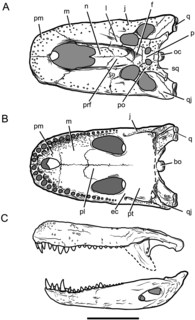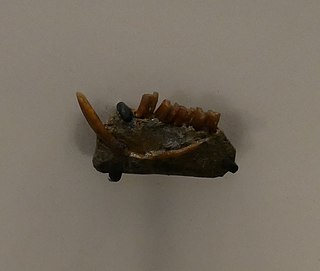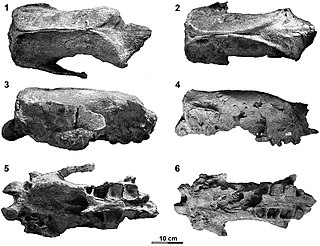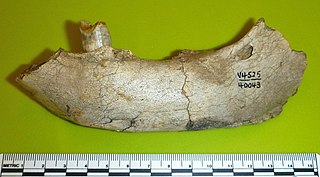
Phoberomys pattersoni is an extinct rodent that lived in the ancient Orinoco River delta around 8 million years ago. It was the second-largest of the roughly seven species of its genus. Like many other rodents, Phoberomys was a herbivore with high-crowned premolars and molars.
Phoberomys is an extinct genus of rodents. Fossil specimens from the Late Miocene period have been discovered in the Ituzaingó Formation of Argentina, the Solimões Formation of Brazil, the Urumaco Formation at Urumaco in Venezuela, and the Pliocene of Peru.

Caviomorpha is the rodent infraorder or parvorder that unites all New World hystricognaths. It is supported by both fossil and molecular evidence. The Caviomorpha was for a time considered to be a separate order outside the Rodentia, but is now accepted as a genuine part of the rodents. Caviomorphs include the extinct Heptaxodontidae and extant families of chinchilla rats, hutias, guinea pigs and the capybara, chinchillas and viscachas, tuco-tucos, agoutis, pacas, pacaranas, spiny rats, New World porcupines, coypu and octodonts.

Purussaurus is an extinct genus of giant caiman that lived in South America during the Miocene epoch, from the Friasian to the Huayquerian in the SALMA classification. It is known from skull material found in the Brazilian and Peruvian Amazon, Colombian Villavieja Formation, Panamanian Culebra Formation and the Urumaco and Socorro Formations of northern Venezuela.

Urumaco is a town in Falcón State in Venezuela. It is of interest to paleontologists due to its rich fossil history. The arid climate of the region means that the fossils are not hidden by vegetation. The fossils were first made known to science by geologists who came across them while looking for oil, which is abundant in some parts of Venezuela. The paleontological wealth of Urumaco makes it the most fossil-rich zone of northern South America.

The Eocardiidae are an extinct family of caviomorph rodents from South America. The family is probably ancestral to the living family Caviidae, which includes cavies, maras, and capybaras and their relatives. McKenna and Bell (1997) divided eocardiids into two subfamilies, Luantinae for two of the oldest genera and Eocardiinae for remaining genera. Kramarz (2006) has recommended the abandonment of these subfamilies, as the genera placed in Luantinae appear to represent basal eocardiids, rather than a specialized side branch. The latter hypothesis had been proposed by Wood and Patterson (1959).

Eomyidae is a family of extinct rodents from North America and Eurasia related to modern day pocket gophers and kangaroo rats. They are known from the Middle Eocene to the Late Miocene in North America and from the Late Eocene to the Pleistocene in Eurasia. Eomyids were generally small, but occasionally large, and tended to be squirrel-like in form and habits. The family includes the earliest known gliding rodent, Eomys quercyi.

Cephalomyidae is an extinct family of caviomorph rodents from South America. The specific relationships of the family are uncertain, and affinities to both chinchilloid and cavioid rodents have been supported. Most recently, Kramarz in 2005 performed a phylogenetic analysis supporting a relationship to the Cavioidea, as represented by Eocardiidae, although more recent analyses have placed them among the chinchilloids as relatives of the giant neoepiblemid rodents. McKenna and Bell (1997) questioned the validity of the family, placing the cephalomyid genera then known in Dasyproctidae, but Kramarz (2001) subsequently reasserted the distinctiveness of cephalomyids.

Josephoartigasia is an extinct genus of enormous dinomyid rodent from the Early Pliocene to Early Pleistocene of Uruguay. The only living member of Dinomyidae is the pacarana. Josephoartigasia is named after Uruguayan national hero José Artigas. It contains two species: J. magna described in 1966 by a left mandible, and J. monesi described in 2008 by a practically complete skull. Both are reported from the San José Member of the Raigón Formation by the Barrancas de San Gregorio along the shores of Kiyú beach.
The Huayquerian age is a period of geologic time within the Late Miocene epoch of the Neogene, used more specifically within the SALMA classification. It follows the Mayoan and precedes the Montehermosan age.

Gryposuchus is an extinct genus of gavialid crocodilian. Fossils have been found from Argentina, Colombia, Venezuela, Brazil and the Peruvian Amazon. The genus existed during the Miocene epoch. One recently described species, G. croizati, grew to an estimated length of 10 metres (33 ft). Gryposuchus is the type genus of the subfamily Gryposuchinae, although a 2018 study indicates that Gryposuchinae and Gryposuchus might be paraphyletic and rather an evolutionary grade towards the gharial.
Ikanogavialis is an extinct genus of gavialid crocodilian. Fossils have been found in the Urumaco Formation in Urumaco, Venezuela and the Solimões Formation of Brazil. The strata from which remains are found are late Miocene in age, rather than Pliocene as was once thought. A possible member of this genus survived into the Late Holocene on Muyua or Woodlark Island in Papua New Guinea.
Phoberomys insolita is an extinct species of rodent that was known as the largest rodent on earth, before the discovery of Josephoartigasia monesi. Fossil specimens from the Late Miocene period have been discovered in the Ituzaingó Formation of Argentina.
The Urumaco Formation is a formation in Venezuela that includes deposits from the Late Miocene. It is the site of several "giant forms": the turtles, crocodiles, sloths and rodents of Urumaco are among the largest of their groups.
Phoberomys burmeisteri is an extinct rodent that lived in the late Miocene of southern South America. Their remains were recovered from the Ituzaingó Formation in Entre Ríos Province, Argentina.
Pseudoprepotherium is an extinct genus of sloths in the family Mylodontidae. It was widespread across northern South America during the Middle and Upper Miocene around 21 to 5.3 million years ago. Fossil finds are known from Brazil Venezuela and Peru. Pseudoprepotherium lived in a tropical climate with a water-rich environment. The remains are limited to limb bones, with the exception of a few skulls and teeth. Based on this, it is a medium to large-sized mylodontid. The genus was described in 1961 and currently contains three species, which were originally assigned to different genera.

Proeremotherium is an extinct genus of megatheriine ground sloths in the family Megatheriidae. It lived during the Late Miocene and Early Pliocene of what is now Venezuela. So far, two largely complete skulls have been recovered in the Falcón Basin in Venezuela. The finds identify the animals as medium-sized representatives of the Megatheriidae. In the cranial anatomy, Proeremotherium resembles the later and giant Eremotherium. It is therefore assumed that the two ground sloths are directly related to each other.
Bolivartherium is an extinct genus of mylodontine mylodontid sloth that lived during the Late Miocene and Late Pliocene in what is now Venezuela. Fossils have been found in the Codore and Urumaco Formations of Venezuela.

Magdalenabradys is an extinct genus of mylodontid ground sloths that lived during the Middle Miocene and Early Pliocene of what is now Colombia and Venezuela. Fossils have been found in the Villavieja Formation of the Honda Group in Colombia, and the Codore and Urumaco Formations of Venezuela.

Perimys is an extinct genus of neoepiblemid rodent that lived from the Early to Late Miocene in what is now South America. Fossils have been found in the Cerro Bandera, Cerro Boleadoras, Ituzaingó, Santa Cruz, and Sarmiento Formations of Argentina, and the Galera, Santa Cruz and Río Frías Formations of Chile.











